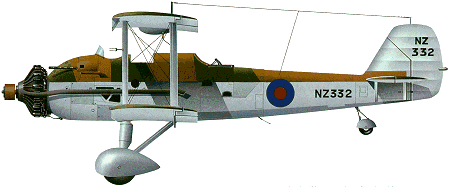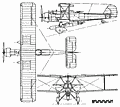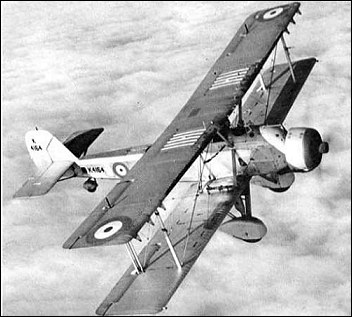|
| The all-metal Vildebeest was adopted by the RAF as a standard torpedo-carrying and bombing biplane and went into service in Mk.I form in 1933. Powered by a 462kW Bristol Pegasus IM3 engine, it was of unusual shape, with the pilot occupying an open cockpit below the leading edge of the upper wing and the observer aft of the wings in a shallower and lower section of the fuselage. A prone bombing position was provided below the pilot's seat. Armament comprised one fixed Vickers gun firing through the propeller and one Lewis gun on a Scarff ring over the back cockpit. The crutch for the 450mm torpedo or bomb rack was under the fuselage between the two legs of the landing gear. The Mk.I was followed into service by the Mks.II to IV, powered by 484kW Pegasus IIM3 and 603kW Bristol Perseus VIII engines. Total production for the RAF was just over 200, about half of which were still operational at the outbreak of World War II. In addition the Vildebeest was adopted by the Spanish Ministry of Marine as a standard torpedo-carrying seaplane and a batch of about 27 were ordered from the Spanish CASA firm, which had acquired a manufacturing licence. These were powered by 443kW Hispano-Suiza 12Nbr engines. Subsequently the RNZAF also acquired more than 30 Vildebeests.

| MODEL | Vildebeest Mk.IV |
| WEIGHTS |
| Take-off weight | 3856 kg | 8501 lb |
| Empty weight | 2143 kg | 4725 lb |
| DIMENSIONS |
| Wingspan | 14.94 m | 49 ft 0 in |
| Length | 11.48 m | 38 ft 8 in |
| Height | 4.47 m | 15 ft 8 in |
| Wing area | 67.63 m2 | 727.96 sq ft |
| PERFORMANCE |
| Max. speed | 251 km/h | 156 mph |
| Ceiling | 5180 m | 17000 ft |
| Range | 1014 km | 630 miles |
| ARMAMENT | 2 x 7.7mm machine-guns, 1 x 457mm torpedo or 450kg of bombs |
 | A three-view drawing of Type 286 Vildebeest Mk IV (672 x 600) |
| Dennis Tyra, e-mail, 08.10.2023 19:42 One can only imagine what the Japanese thought when they saw some Vildebeests lumbering towards them in Malaya 41 /42. Aircraft or prehistoric birds. reply | | George Howe, e-mail, 21.01.2016 13:16 In about 1954 came across bits of a radial engine in Langdale. `an excellent book by Doug Brown mentions a Vildebeest crash. The master con rod was there, and a 4 valve cylinder head, wonder if all the engines had 4 valves? Hope to get back 2016 WLYK if its still there & findable. reply | | Wellesley, e-mail, 17.05.2015 11:57 Also there were Vincents serving in the Middle East and East Africa during 1940-42. I believe that No.47 squadron in the Sudan is an example that used the Vincents alongside the Wellesley when engaging the Italians in Abysinia. They were then finally retired in 1942. reply | | GERALD LEATHAM, e-mail, 31.01.2013 16:27 My father flew these aircraft in W.W.2 in fiji in the R.N.Z.A.F. IN THE EARLIER STAGES of the war reply | |
| | loulou, 20.06.2011 13:30 I know there were some in the pacific at the outbreak of the war. Also combat of RNZAF and spanish aircraft would be of interest. Thanks. reply | | Ken Gregory, e-mail, 22.05.2009 06:03 I am about to use the three view drawing from whic to draw a 1 /12 th. scale plan. From this I will build a 49" wingspan, electric powered model.With the longish nose( for a biplane of that period) it should be easy to balance, and with the large wing area and plenty of drag, should fly in a very scale-like manner.I remember this aeroplane as one of a set of Players Cigarette cards I had as a schoolboy in the 30's.In fact other threads on this aircraft depict that very card! reply | | Old Man, e-mail, 05.12.2007 10:57 The photograph is of a Vildebeest Mk. IV, which had a Perseus engine, instead of the Pegasus of earlier marks, and was fitted with a long-chord cowling for the motor. Two Coastal Command squadrons were still equipped with these at the start of WWII, but were quickly replaced and saw no combat. Vildebeests remained in service at Singapore, and were used in combat against the Japanese in Malaya, and some survivors I believe also in Java, attempting to bomb Japanese troops and landings. They were slaughtered in the air by Japanese fighters. Their principal opponents in Malaya were Oscars, and in Java Zeroes.
The Spanish Vildebeests were fitted with Hispano-Suiza twelve cylinder V motors, and had a very different appearance in consequence. I believe some were employed during the Civil War by the Republicans, but know no details. reply | | Dan, e-mail, 07.09.2007 00:02 The colour picture above is actually a Vickers Vincent, which was the tropical version of the Vildebeest. The engine was left uncowled in order to aid cooling in hot climates. reply | | Damon, e-mail, 09.05.2007 16:59 I was just wondering if the aircraft in the picture is spanish? It looks like it has a different engine from the Vickers manufactured ones. Also I have a 15 year old son who is a terrific aviation artist who loves to paint obscure aircraft and scenes from WW2. Is there any information on the combat careers of the Vildebeest? I know there were some in the pacific at the outbreak of the war. Also combat of RNZAF and spanish aircraft would be of interest. Thanks. reply |
|
Do you have any comments?
|
| 
COMPANY
PROFILE
All the World's Rotorcraft
|








